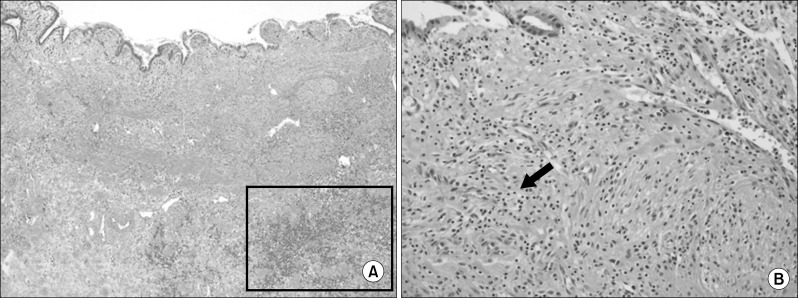Korean J Hepatobiliary Pancreat Surg.
2012 May;16(2):65-69. 10.14701/kjhbps.2012.16.2.65.
Peripheral eosinophilia - is it a predictable factor associated with eosinophilic cholecystitis?
- Affiliations
-
- 1Department of Surgery, Chonnam National University Medical School, Gwangju, Korea. 3rdvivace@hanmail.net
- 2Department of Radiology, Chonnam National University Medical School, Gwangju, Korea.
- 3Department of Pathology, Chonnam National University Medical School, Gwangju, Korea.
- KMID: 2083325
- DOI: http://doi.org/10.14701/kjhbps.2012.16.2.65
Abstract
- BACKGROUNDS/AIMS
The purpose of this study was to evaluate the role of peripheral eosinophilia as a predictable factor associated with Eosinophilic cholecystitis (EC) compared with other forms of cholecystitis in patients who underwent a cholecystectomy.
METHODS
Between January 2001 and May 2011, the histopathologic features of 3,539 cholecystectomy specimens were reviewed retrospectively. EC was diagnosed in 30 specimens (0.84%). Data from 30 consecutive patients with EC (eosinophilic cholecystitis group [E-group]) were compared with a retrospective control group of 60 patients (other cholecystitis group [O-group]) during the same period. The two groups were matched for age, gender, and the presence of cholelithiasis.
RESULTS
The median absolute eosinophil count 1 day post-operatively was 144 cells/mm3 (range: 9-801 cells/mm3) in the E-group and 93 cells/mm3 (range: 0-490 cells/mm3) in the O-group (p=0.036). Pre-operative peripheral eosinophilia was more common in the E-group than the O-group (20% vs. 3.3%, p=0.015). Multivariate analysis revealed that pre-operative peripheral eosinophilia was an independent significant predictable factor associated with EC (odds ratio=7.250, 1.365 <95% confidence interval<38.494, p=0.020).
CONCLUSIONS
In the present study, pre-operative peripheral eosinophilia was shown to be an independent predictable factor associated with EC. Further researches seem to be necessary to confirm this finding.
MeSH Terms
Figure
Cited by 1 articles
-
Eosinophilic cholecystitis: A rare manifestation of hypereosinophilic syndrome
Jae-Hyun Park, Byoung-Hoon Kim, Mi-Kang Kim, Jae-Eun Lee, Kwang-Taek Kim, Jun-Jae Yoo, Hee-Jun Kim, Sung-Won Jung, Cheol-Hong Kim, In-Gyu Hyun, Jeong-Hee Choi
Allergy Asthma Respir Dis. 2014;2(3):222-226. doi: 10.4168/aard.2014.2.3.222.
Reference
-
1. Kim YH. Eosinophilic cholecystitis in association with clonorchis sinensis infestation in the common bile duct. Clin Radiol. 1999; 54:552–554. PMID: 10484225.
Article2. Fox H, Mainwaring AR. Eosinophilic infiltration of the gallbladder. Gastroenterology. 1972; 63:1049–1052. PMID: 4639359.
Article3. Felman RH, Sutherland DB, Conklin JL, et al. Eosinophilic cholecystitis, appendiceal inflammation, pericarditis, and cephalosporin-associated eosinophilia. Dig Dis Sci. 1994; 39:418–422. PMID: 8313827.
Article4. Sánchez-Pobre P, López-Ríos Moreno F, Colina F, et al. Eosinophilic cholecystitis: an infrequent cause of cholecystectomy. Gastroenterol Hepatol. 1997; 20:21–23. PMID: 9072192.5. Punia RP, Arya S, Jain P, et al. Eosinophilic and lympho-eosinophilic cholecystitis. Indian J Gastroenterol. 2003; 22:153–154. PMID: 12962447.6. Hellstrom HR. Eosinophilic and lymphoeosinophilic cholecystitis. Am J Surg Pathol. 1994; 18:215–216. PMID: 8291662.7. Kaji K, Yoshiji H, Yoshikawa M, et al. Eosinophilic cholecystitis along with pericarditis caused by Ascaris lumbricoides: a case report. World J Gastroenterol. 2007; 13:3760–3762. PMID: 17659742.8. Albot G, Poilleux , Olivier C, et al. Les cholecystites a eosinophils. Presse Med. 1949; 39:558–559. PMID: 18146682.9. Malik KA. Eosinophilic cholecystitis: an infrequent cause of cholecystectomy. Pakistan J Med Sci. 2010; 26:724–725.10. Adusumilli PS, Lee B, Parekh K, et al. Acalculous eosinophilic cholecystitis from herbal medicine: a review of adverse effects of herbal medicine in surgical patients. Surgery. 2002; 131:352–356. PMID: 11894043.
Article11. Tefferi A. Blood eosinophilia: a new paradigm in disease classification, diagnosis, and treatment. Mayo Clin Proc. 2005; 80:75–83. PMID: 15667033.
Article12. Dabbs DJ. Eosinophilic and lymphoeosinophilic cholecystitis. Am J Surg Pathol. 1993; 17:497–501. PMID: 8470764.
Article13. Rosengart TK, Rotterdam H, Ranson JH. Eosinophilic cholangitis: a self-limited cause of extrahepatic biliary obstruction. Am J Gastroenterol. 1990; 85:582–585. PMID: 2337061.14. Russell CO, Dowling JP, Marshall RD. Acute eosinophilic cholecystitis in association with hepatic echinococcosis. Gastroenterology. 1979; 77:758–760. PMID: 467933.
Article15. Tenner S, Roston A, Lichtenstein D, et al. Eosinophilic cholangiopathy. Gastrointest Endosc. 1997; 45:307–309. PMID: 9087841.
Article16. al-Abdulla NA, Schulick RD, Regan F. Hypereosinophilic sclerosing cholangitis: findings using half-Fourier magnetic resonance imaging. Hepatogastroenterology. 2000; 47:359–361. PMID: 10791189.17. Hepburn A, Coady A, Livingstone J, et al. Eosinophilic cholecystitis as a possible late manifestation of the eosinophilia-myalgia syndrome. Clin Rheumatol. 2000; 19:470–472. PMID: 11147758.
Article18. Shakov R, Simoni G, Villacin A, et al. Eosinophilic cholecystitis, with a review of the literature. Ann Clin Lab Sci. 2007; 37:182–185. PMID: 17522376.19. Tajima K, Katagiri T. Deposits of eosinophil granule proteins in eosinophilic cholecystitis and eosinophilic colitis associated with hypereosinophilic syndrome. Dig Dis Sci. 1996; 41:282–288. PMID: 8601370.
Article20. Butler TW, Feintuch TA, Caine WP Jr. Eosinophilic cholangitis, lymphadenopathy, and peripheral eosinophilia: a case report. Am J Gastroenterol. 1985; 80:572–574. PMID: 4014110.21. Muhlberger F. Morphology of eosinophilic cholecystitis and the problem of its allergic genesis. Int Arch Allergy Appl Immunol. 1954; 5:434–448. PMID: 13232743.22. Parry SW, Pelias ME, Browder W. Acalculous hypersensitivity cholecystitis: hypothesis of a new clinicopathologic entity. Surgery. 1988; 104:911–916. PMID: 3187904.
- Full Text Links
- Actions
-
Cited
- CITED
-
- Close
- Share
- Similar articles
-
- A Case of Eosinophilic Cholecystitis associated with Eosinophilic Cholangitis and Pancreatitis
- A Case of Idiopathic Eosinophilic Cholecystitis Treated with Steroids
- A case of eosinophilic cholecystitis associated with gallstones
- A Case of Acute Cholecystitis Combined with Eosinophilic Pericarditis Caused by Toxocariasis
- A case of eosinophilic cholecystitis with hepatitis associated with clonorchiasis


